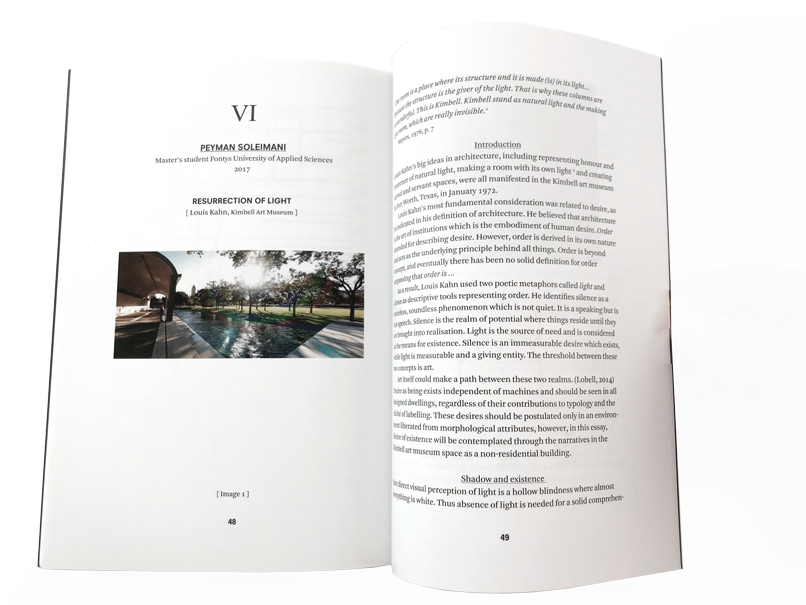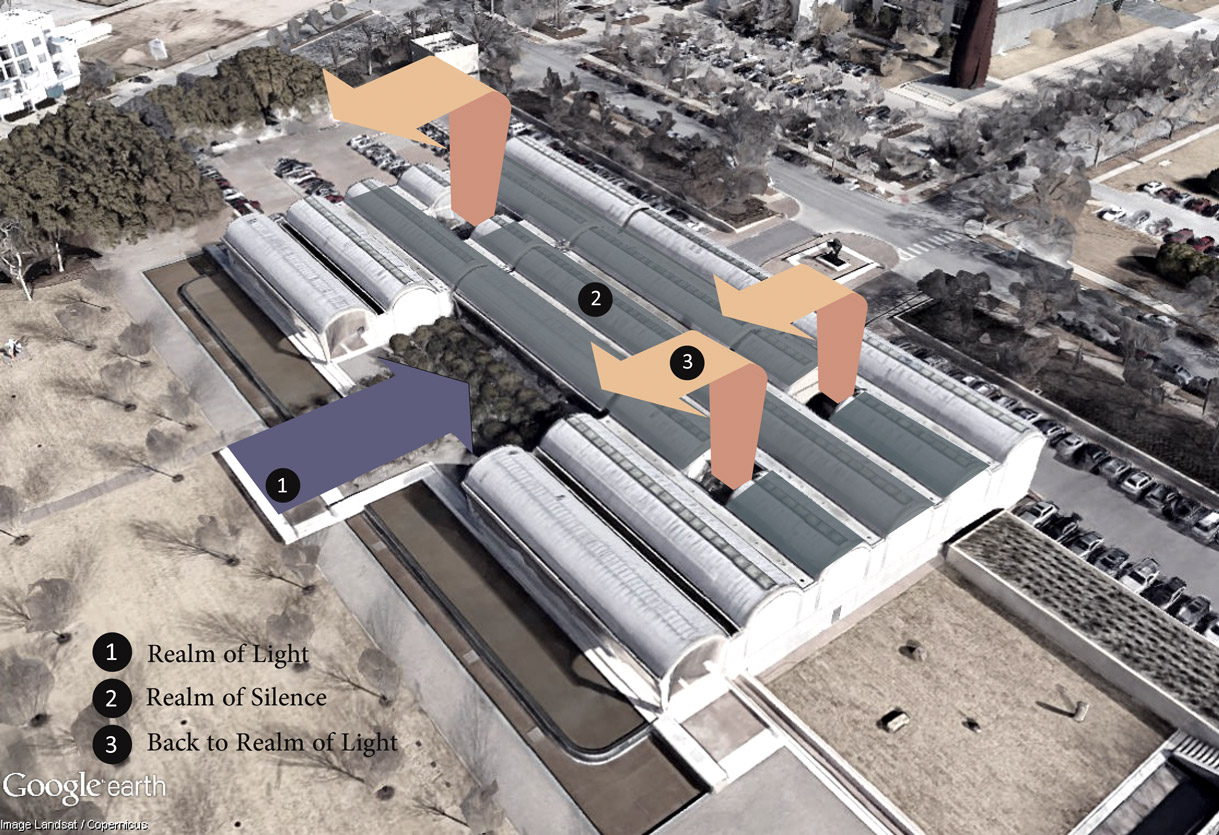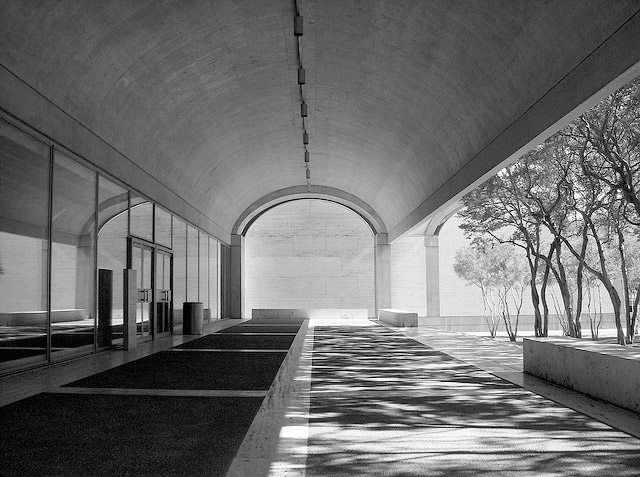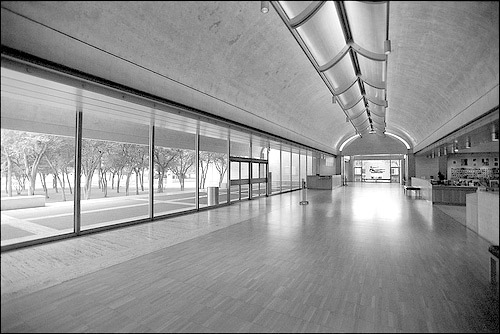
RESURRECTIOn Of LIGHt
Louis.I. Khan – Kimbell Art Museum
INTRODUCTIOn
Academic architecture award is an organization which is supported by “Virta and each year held a contest for all the master of architecture student in Europe. This year, the goal of the contest was about introducing high-quality architectural realization of each student choice in four sections of residential, interior Architecture, public spaces and non-residential, in a format of an essay. As a result of that, I decided to write down an introduction to both Louis.I. Khan – my favorite architect- ideology and Kimbell Art Museum as one of Kahn`s masterpiece during his professional career. Through my analysis which previously I made, I tried to construct a story through the spaces of the museum and link Kahn`s philosophy to the narrative which I made in using the building. Also, I selected as honorable mentioned in the nonresidential section.

Abstract isometric view of the Kimbell Art Museum spaces and different narratives
The first task was to approach “Louis I Kahn” complicated philosophy about “Light” and “Silence” and try to understand them as much as possible. Then finding an effect or phenomenon to link these two metaphors. Thus I come out with the relation of shadow and our existence and how direct light represent “realm of Light” which could create shadow and define our existence and indirect light represent “realm of Silence” where There are no shadows and our existence enter in to realm of potentials and ready to step forward in to realm of realization. As a matter of fact, in this manner, the “Art” itself positioned in between
these two realms and it is a gate from which we could cross “Light” and “silence”. Linking these ideas into spaces of the Kimbell art Museum needs a solid narrative which starts from the entrance area which is filled with trees to one of the open courtyard inside the museum, where the play of shadows, direct and indirect light and silence and visitor moods have been considered.

The entrance area represents the direct light and the desire for the existence of all the substances and even of the building itself. Visitors become tranquil and calm by looking at the silhouettes of the trees and find their existence by looking at their own shadow. The long corridors with the indirect lighting represent the silence where there is no casting of shadows inside. This is the realm of potential, every object resides here before the realization phase. The art pieces which are the threshold of the realms of silence and light are placed in this section and allow the visitors to detach from their existence which they interpreted earlier in the entrance area. Finally, in the light courts, visitors face the meaning of a room which is made by light, with Kahn placing his ideological focus on it. Here, the viewer can experience the shadow and existence of object for the second time, but this time after understanding the art and the realm of silence. The ambiance in the light courts reproduces what has been experienced outside the “Kimbell art museum”, with silence and art itself placed in between.
what I learned from writing this essay and participating in Academic Architecture Awards was understating different possibilities for describing a building and how the role of
the introduction of a narrative into architectural spaces could affect people behavior and movement. My certain goal in writing an essay about Kimbell art museum was an effort to narrow down some of my philosophical thoughts related to “Louis.I.khan” himself and his ideas in making Kimbell museum, which I was successful and I could be selected by the jury of the contest as an honorable mention in non-residential section.

WHITe LIGHt
The five proportioned concrete domes are of important visual significance to the Kimbell art museum. They present no opening on either northern or southern sides. In summer, the entrance area is covered by rows of planted trees and resembles a green canopy which
filters the light and softens the hot Texan weather to create a calm and temperate ambiance. It offers a sense of tranquillity to the visitors before they enter the building. The desire for existence can also be perceived by the shadows of the trees in the entrance area and the shadow of building itself, which intensify the presence of direct light as a starting point for
a typical narrative for visitors experiencing the building’s spaces.

SILVEr LIGHt
Because of the specifically designed light openings in the roof, there is no gap in the realization of the spaces, and both entrance and gallery areas are mixed accordingly. A mysterious and prevalent silver light comes from the ceiling and illuminates the
art which is on a threshold between light and silence. What really has been pictured in the indoor corridors is the presence of silence, created by avoiding shadows in these places.
All the art pieces are visible while their “being” is happening in the realm of silence seeking the realm of light, where they face direct light and by means of their own shadows, their “being” transforms into existence.

GREEn LIGHt
The courtyard resembles the moments where the viewer begins his expedition from outside to the inside of the building with all the trees and water ponds in the entrance area. Only now, the standpoint of the viewer has been altered following the experience of “silence” in the exhibition corridors. Also, the idea of the room which is mentioned in Kahn’s philosophy can
be seen as an invisible criterion among the spaces of the museum. A single visitor who has been seeing all the art pieces and feels the potential of the realm of silence now faces the direct light, and suddenly shadows appear again. In other words, through the means of shadows, inside these courts, another layer of understanding has been added to place, visitor and objects altogether.
